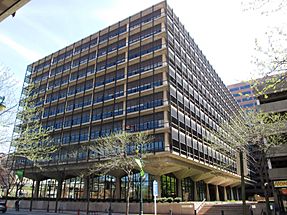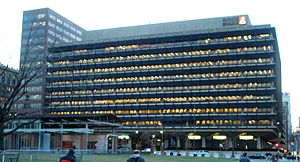Rohm and Haas Corporate Headquarters facts for kids
Quick facts for kids |
|
|
Rohm and Haas Corporate Headquarters
|
|

(2013)
|
|
| Location | 100 South Independence Mall West Philadelphia, Pennsylvania |
|---|---|
| Built | 1964 |
| Architect | Pietro Belluschi Alexander Ewing for George M. Ewing Co. |
| Architectural style | International style |
| NRHP reference No. | 07000031 |
| Added to NRHP | February 9, 2007 |
The Rohm and Haas Corporate Headquarters is a famous building in Philadelphia, Pennsylvania, United States. It used to be the main office for a company called Rohm and Haas, which made chemicals. Finished in 1964, it was the first private building to help make the Independence Mall area look new and better.
It's only two blocks from Independence Hall, a very important historical place. The building was designed by Pietro Belluschi and George M. Ewing Co. People really liked how it fit in with the nearby park and old buildings. City planners in Philadelphia said it was a great example for all new buildings in the area.
The nine-story building is special because of its see-through, wavy sunscreens. These sunscreens are made from Plexiglas, a main product of Rohm and Haas. They are held up by aluminum lattices all over the building's outside. In 2007, the Rohm and Haas Corporate Headquarters was added to the National Register of Historic Places. Today, it is seen as one of the best examples of the International style of architecture.
Building History
The idea for the Rohm and Haas Corporate Headquarters came from Philadelphia's plan to improve the area around Independence Hall. Besides creating a park north of Independence Hall, new buildings were planned. These included a federal courthouse and a new Philadelphia Mint.
For the Independence Mall area to be rebuilt, city planner Edmund Bacon asked Otto Haas to move his company, Rohm and Haas, to Independence Mall. Rohm and Haas was a chemical company based in Philadelphia. A story says that Otto Haas believed the city would not survive if companies like his left it. Also, the government offered money to private companies that invested in rebuilding city areas. This helped Rohm and Haas decide to stay in Philadelphia.
In 1959, Rohm and Haas was the first private company to build on Independence Mall. They first asked George M. Ewing Co. from Philadelphia to design their new main office. But the city's art committee didn't like Ewing's design. So, Rohm and Haas decided to hire a famous architect, Pietro Belluschi.
At that time, Belluschi was the head of architecture at the Massachusetts Institute of Technology. He worked with George M. Ewing Co. to change the first design. The new design was ready in a few months. It was approved by Rohm and Haas and several city groups. Construction started in 1963 and finished in 1964. It cost about US$10 million. Rohm and Haas moved into the new building in 1965.
By the 2000s, the building needed updates. The company spent two years deciding whether to fix their current building or move to a newer, cheaper office in Center City. In 2006, Rohm and Haas chose to stay and spend up to US$25 million on renovations. They stayed because the building's design allowed different departments to be on the same floor. In a tall skyscraper, departments might have to be spread out over many floors.
RMJM Hillier was hired to do the renovations. The first plan was good but cost too much. To help pay, RMJM Hillier tried to get the building named a National Historic Landmark. This would give the company tax credits. Buildings usually need to be at least fifty years old for this. However, the building's importance in Modern architecture kept the state of Pennsylvania and the National Park Service interested. The building was not named a National Historic Landmark, but it was added to the National Register of Historic Places on February 9, 2007.
To help get the building listed as historic, the renovations focused on making the office space more open and updating systems. A part of the original plan that would have changed the building's outside look was stopped. However, the outside was thoroughly cleaned. Inside, many closed offices were removed and replaced with open work areas. This new design also let more light into the building. The work areas got new furniture, replacing some that were from the 1960s. The dining area moved from the basement to the street level. This space used to be a bank and had been empty for years. Security, phone, and central plant systems were also updated. The inside renovations finished around May 2008. Improvements to the area outside the building were completed a few months later.
Building Design
Pietro Belluschi and George M. Ewing Co. changed the original design of an office tower. They made the Rohm and Haas Corporate Headquarters into a large, low building with nine stories. It covers about 300,000 square feet (27,870 square meters). Located at 6th Street and Market Street, it faces Independence Mall.
The building is made of reinforced concrete. It sits on wide concrete columns and is set back from the street by a raised plaza. This landscaped plaza goes through the middle of the ground floor. It opens up to a larger plaza with a fountain and a small pool. The plaza behind the building lets people walk through an alley to Seventh Street.
To help keep the building cool, Belluschi added bronze-colored, see-through, wavy sunscreens to the outside. These sunscreens are made of Plexiglas, a main product of Rohm and Haas. They are held up by a bronze-colored aluminum lattice. The sunscreens and dark colors give the building's outside a textured look. This design helps the building not look too big. Plexiglas was also used inside the building, in the board room, and in some art and light fixtures designed by György Kepes.
Philadelphia's city planners really liked the building. They felt it set a standard for new buildings in the area. The building was designed to look different from the nearby 18th-century Georgian architecture, but not to overpower it. Wolf Von Eckardt, an architecture critic, praised the building. He said it showed respect for the nearby historic buildings. He also noted how it connected to the small size of Independence Hall and the large open space of Independence Mall. The building has been called "a very well done rational office building." Today, the Rohm and Haas Corporate Headquarters is considered one of the best examples of the International style of architecture.
Images for kids
See also
 In Spanish: Rohm and Haas Corporate Headquarters para niños
In Spanish: Rohm and Haas Corporate Headquarters para niños







